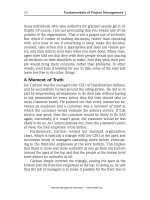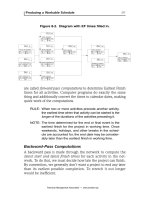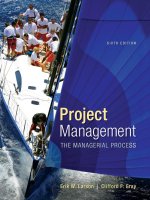Exploring management 6th by schermerhornch06
Bạn đang xem bản rút gọn của tài liệu. Xem và tải ngay bản đầy đủ của tài liệu tại đây (661.15 KB, 35 trang )
Exploring
Management
John Schermerhorn, Jr. and Daniel Bachrach
Sixth Edition
Chapter 6
Controls and Control Systems
“Self-awareness is crucial . . .
but when it comes to
understanding how others see
us, many of us are in the dark . .
leads to bad decisions and
spoiled relationships.”
Copyright © 2018 John Wiley & Sons, Inc.
2
Your Chapter 6 Takeaways
• How and why do managers use the control
process? (6.1)
• What types of controls are used by
managers? (6.2)
• What are some useful organizational control
tools and techniques? (6.3)
Copyright © 2018 John Wiley & Sons, Inc.
3
HOW AND WHY MANAGERS USE THE CONTROL PROCESS 6.1
Takeaway 6.1 – answers to come
• Controlling is one of the four management
functions.
• Step 1 - Control begins with objectives and
standards.
• Step 2 - Control measures actual performance.
• Step 3 - Control compares results with objectives
and standards.
• Step 4 - Control takes corrective action as needed.
Copyright © 2018 John Wiley & Sons, Inc.
4
HOW AND WHY MANAGERS USE THE CONTROL PROCESS 6.1
Control as a Management Function
• Controlling is the process of measuring
performance and taking action to ensure desired
results.
Figure 6.1 Why Is Controlling So
Important in the Management Process?
Copyright © 2018 John Wiley & Sons, Inc.
5
HOW AND WHY MANAGERS USE THE CONTROL PROCESS 6.1
Control Process
Step 1:
Control begins with
objectives and standards.
– Output standards measure
results in terms of
quantity, quality, cost, or
time.
– Input standards measure
the work efforts that go
into the performance task.
Figure 6.2 What Are the Four
Steps in the Control Process?
Copyright © 2018 John Wiley & Sons, Inc.
6
HOW AND WHY MANAGERS USE THE CONTROL PROCESS 6.1
Control Process
Step 2:
Control measures actual
performance.
– Agreed-upon standards
– Accurate and timely
measurement
Figure 6.2 What Are the Four
Steps in the Control Process?
Copyright © 2018 John Wiley & Sons, Inc.
7
HOW AND WHY MANAGERS USE THE CONTROL PROCESS 6.1
Control Process
Step 3:
Control compares results
with objectives and
standards
Desired Performance
- Actual Performance
Need for action
Figure 6.2 What Are the Four
Steps in the Control Process?
Copyright © 2018 John Wiley & Sons, Inc.
8
HOW AND WHY MANAGERS USE THE CONTROL PROCESS 6.1
Control Process
Step 4:
Control takes corrective
action as needed.
– Management by
exception is the
practice of giving
attention to situations
that show the
greatest need.
Figure 6.2 What Are the Four
Steps in the Control Process?
Copyright © 2018 John Wiley & Sons, Inc.
9
HOW AND WHY MANAGERS USE THE CONTROL PROCESS 6.1
Study Guide for Takeaway 6.1
Rapid Review:
• Controlling is the process of measuring performance and taking corrective action as
needed.
• The control process begins when performance objectives and standards are set; both
input standards for work efforts and output standards for work results can be used.
• The second step in control is to measure actual performance in the control process.
• The third step compares results with objectives and standards to determine the need
for corrective action.
• The final step in the control process involves taking action to resolve problems and
improve things in the future.
• The control equation states:
Need for Action = Desired Performance - Actual Performance.
• Management by exception focuses attention on the greatest need for action.
Copyright © 2018 John Wiley & Sons, Inc.
10
HOW AND WHY MANAGERS USE THE CONTROL PROCESS 6.1
Study Guide for Takeaway 6.1
Questions for Discussion:
1. What performance standards should guide a
hospital emergency room or fire department?
2. Can one control performance equally well with
input standards and output standards?
3. What are the possible downsides to
management by exception?
Copyright © 2018 John Wiley & Sons, Inc.
11
HOW AND WHY MANAGERS USE THE CONTROL PROCESS 6.1
Be Sure You Can…for Takeaway 6.1
• explain the role of controlling in the management
process
• list the steps in the control process
• explain how planning and controlling should
work together in management
• differentiate output standards and input
standards
• state the control equation
• explain management by exception
Copyright © 2018 John Wiley & Sons, Inc.
12
TYPES OF CONTROLS USED BY MANAGERS 6.2
Takeaway 6.2 – answers to come
• Managers use feedforward, concurrent, and
feedback controls.
• Managers use both internal and external controls.
• Management by objectives is a way of integrating
planning and controlling.
Copyright © 2018 John Wiley & Sons, Inc.
13
TYPES OF CONTROLS USED BY MANAGERS 6.2
Types of Controls
• Organizations are open systems that interact with
environment with input, throughput, and output
controls
Figure 6.2 What Are the Differences Between Feedforward,
Concurrent, and Feedback Controls?
Copyright © 2018 John Wiley & Sons, Inc.
14
TYPES OF CONTROLS USED BY MANAGERS 6.2
Internal and External Controls
• Internal Control
• Motivated employees exercise selfcontrol in their work.
• Participation in planning work and
having a sense of purpose facilitate
motivation.
Copyright © 2018 John Wiley & Sons, Inc.
15
TYPES OF CONTROLS USED BY MANAGERS 6.2
Internal and External Controls
External Control
• Bureaucratic Control
• Involves policies, procedures, budgets and
supervision to influence behavior
• Clan Control
• Uses the organization’s culture to influence
behavior
• Market Control
• Influence that market competition has on
organizational decisions such as price, product
Copyrightexpansions.
© 2018 John Wiley & Sons, Inc.
modification, and
16
TYPES OF CONTROLS USED BY MANAGERS 6.2
Objectives
Management By Objectives (MBO)
• Superior and subordinate jointly plan objectives
Figure 6.4 How Does Managing by Objectives
Help To Integrate Planning and Controlling?
Copyright © 2018 John Wiley & Sons, Inc.
17
TYPES OF CONTROLS USED BY MANAGERS 6.2
Objectives
• Types of objectives
• Improvement objectives state goals for
improvement in measurable terms.
• “increase sales by 6%”
• Personal development objectives focus on
personal growth.
• “learn a second language”
Copyright © 2018 John Wiley & Sons, Inc.
18
TYPES OF CONTROLS USED BY MANAGERS 6.2
Objectives
How to Write a Good Performance Objective
Clarify the target—be specific; clearly describe the key result to be
accomplished.
Make it measurable—state how the key result will be measured and
documented.
Define the timetable—identify a date by which the key result will be
accomplished.
Avoid the impossible—be realistic; don’t promise what cannot be accomplished.
Add challenge—be optimistic; build in “stretch” to make the accomplishment
significant.
Don’t overcomplicate—stick to the essentials; write to fit a Post-it note reminder.
Copyright © 2018 John Wiley & Sons, Inc.
19
TYPES OF CONTROLS USED BY MANAGERS 6.2
Study Guide for Takeaway 6.2
Rapid Review:
• Feedforward controls try to make sure things are set up
right before work begins; concurrent controls make sure
that things are being done correctly; feedback controls
assess results after an action is completed.
• Internal control is self-control that occurs as people take
personal responsibility for their work.
• External control is accomplished by use of bureaucratic,
clan, and market control systems.
• Management by objectives is a process through which
team leaders work with team members to “jointly” set
performance objectives and “jointly” review performance
results.
Copyright © 2018 John Wiley & Sons, Inc.
20
TYPES OF CONTROLS USED BY MANAGERS
Study Guide for Takeaway 6.2
Questions for Discussion:
1. How does bureaucratic control differ from clan
control?
2. What is Douglas McGregor’s main point
regarding internal control?
3. Can MBO work when there are problems in the
relationship between a team leader and a team
member?
Copyright © 2018 John Wiley & Sons, Inc.
21
TYPES OF CONTROLS USED BY MANAGERS 6.2
Be Sure You Can…for Takeaway 6.2
• illustrate the use of feedforward, concurrent, and
feedback controls
• explain the nature of internal control or selfcontrol
• differentiate among bureaucratic, clan, and
market controls
• list the steps in the MBO process as it might
operate between a team leader and a team
member
Copyright © 2018 John Wiley & Sons, Inc.
22
CONTROL TOOLS AND TECHNIQUES 6.3
Takeaway 6.3 – answers to come
• Quality control is a foundation of modern management.
• Gantt charts and CPM/PERT improve project management
and control.
• Inventory controls help save costs.
• Breakeven analysis shows where revenues will equal
costs.
• Financial ratios measure key areas of financial
performance.
• Balanced scorecards help top managers exercise strategic
control.
Copyright © 2018 John Wiley & Sons, Inc.
23
CONTROL TOOLS AND TECHNIQUES 6.3
Quality Control
• Quality Control is increasingly
important for global competition
– Total Quality Management
• Commitment to quality
• Striving for zero defects
– Continuous Improvement
• Always searching for new ways
to improve work quality and
performance
• Six Sigma
• No more than 3.4 defects per million
units of goods
Control Charts are used to
spot trends and exceptions to
quality standards
Copyright © 2018 John Wiley & Sons, Inc.
24
CONTROL TOOLS AND TECHNIQUES 6.3
Charts for Project Management
Project Management
• Responsibility for overall
planning and control of
projects
Project Management Tools
Gantt Chart
• Gantt Charts
• CPM/PERT Charts
• Critical Path
CPM/Pert Chart
Copyright © 2018 John Wiley & Sons, Inc.
25









